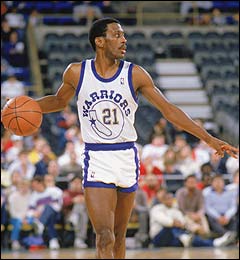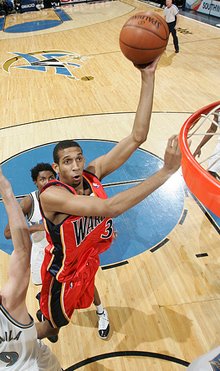 It's not like we need another Brandan Wright, but this Anthony Randolph sounds like Brandan Wright with a jumper - closer to Chris Bosh than Wright in that regard. Like Wright he is skinny and long, can run the floor well, and block shots, but he also has the ability to play the small forward position because of his good handles and ability to take opponents off the dribble and also hit the mid-range jumper.
It's not like we need another Brandan Wright, but this Anthony Randolph sounds like Brandan Wright with a jumper - closer to Chris Bosh than Wright in that regard. Like Wright he is skinny and long, can run the floor well, and block shots, but he also has the ability to play the small forward position because of his good handles and ability to take opponents off the dribble and also hit the mid-range jumper.Nelson loves players that can cause mismatches and Anthony Randolph could turn out to be a great player after a couple of years of development. He's projected to be selected at #5 by ESPN and in the late lottery elsewhere.
You can find several of his games at this link including LSU vs. Florida with Mareesse Speights and Nick Calathes / LSU vs. Tennessee with Tyler Smith:
http://sports.yahoo.com/top/collegebroadcast/teams/jps
Statistics:
http://www.nbadraft.net/admincp/profiles/anthonyrandolph.html
Birthday: 7/15/1989
NBA Comparison: Lamar Odom/Tayshaun Prince
Strengths: Long, lanky forward with a great deal of upside ... His length and agility makes him very unique playing on the wing ... Highly versatile. He has a vast array of offensive abilities, especially impressive considering his age: Randolph has a tremendous handle and gets to the basket extremely well off the bounce ... A smooth athlete with great foot speed ... Runs the floor like a deer and has amazing fluidity ... Really makes a difficult match up as he's able to use his great length on both ends of the floor ... His offensive skill set is developing quickly ... Scores very well around the basket with a wide array of hooks and finger rolls. Being left handed enhances his effectiveness ... Has really developed as the season has gone on, and is beginning to dominate on a regular basis ... Causes mayhem crashing the glass, often following teammates shots with highlight one handed finishes ... Also shows solid vision and playmaking ability for teammates ... Has a lot of defensive potential. Blocks a ton of shots (2.3 pg) for a wing player due to his length, timing and explosiveness ... Shows good promise as a free throw shooter (70%), hard work and repetition should help him increase it ...
Weaknesses: A high risk, high reward type pick at this stage of his career. He's got a chance to be special, but in turn a higher than average chance of being a bust as well ... Still very skinny, and may always be on the skinny side ala Tayshaun Prince ... His arms in particular need bulking up ... His NBA readiness isn't quite at the level of some other draft hopefuls ... Must get stronger and tougher both physically and mentally ... Must gain confidence and not get discouraged when things aren't going well ... Still prone to cold nights shooting the ball ... He's a very shy, quiet kid, and the year in Baton Rouge has been great for him but he could really use a second year to continue his maturity and off court development before taking on the bright lights and distractions that exist at the next level. Unfortunately that appears unlikely, as Randolph is said to be leaning towards entering the draft one-and-done ... Maturity question marks will need to be answered in the evaluation process leading up to the draft. ... Shows a solid shooting stroke, but really need to develop more range. The three ball isn't currently in his repertoire (11% on the year with just two makes) ... Will need to tighten his handle and become less turnover prone ...
Aran Smith - 3/9/2008
Strengths: A raw talent. Extremely versatile forward with great quickness and athleticism ... Has the ability to face the basket, as well as play in the post ... Can get by players off the dribble with his great first step ... Shows a lot of raw potential, especially considering how much he improved over the past year... (Similar to Chris Bosh at the same stage of his career although not as stong)
Aran Smith - 7/3/2006
from DraftExpress:
http://www.draftexpress.com/profile/Anthony-Randolph-1069/
Strengths:• Size• Wingspan• Quickness• Explosiveness• Fluidity• Left-handed• 4/3 mismatch threat (in style right now)• Ability to run the floor• Ball-handling skills• Ability to create shots w/either hand• Mid-range jumper• Shot-blocking• Defensive potential/Quick enough to hedge screens on p’n’r• Only 18 years old• Huge upside
Weaknesses:• Lacks strength• Skinny frame• Lives off instincts/Lacks fundamentals• Forces issue/ Doesn’t know limitations• Turnover prone• Cannot hold spot on the block• Fades away/Struggles finishing through contact• Poor 3-point shooter• Shot selection• All-around defense• Can he guard NBA PFs?• Pushed around in post• Inconsistent motor• Lacks awareness• Always on losing teams• Intangibles?February 21, 2008
Although he continues to largely slip underneath the radar screen as far as national attention goes, few freshman have shown more glimpses of potential than LSU power forward Anthony Randolph.
It all starts with his physical tools…6-10 or 6-11, incredibly long, left-handed, fluid, quick, explosive off his feet, with great open-court speed…Randolph fits the bill and then some. He does have an extremely lanky frame, though (think Brandan Wright), one that might struggle to put on significant weight even down the road.
Skinny or not, Randolph wows you at times with the versatility he displays offensively. He’s a very good ball-handler for his size, able to grab a rebound and take the ball all the way down the floor (weaving through traffic impressively) and finish the play himself, or even create shots for himself in the half-court. His first step is excellent, and he has some basic jab-steps or wiggle moves that keeps his matchup guessing constantly as to what his next move will be. Although he’s left-handed, he seems to be just as dangerous going right, which is quite intriguing considering his size, youth, and the fact that he’s seemingly living purely off his instincts at this point. This ability to face up and attack his man off the dribble makes him a huge mismatch threat at the next level, especially as he continues to polish up his ball-skills, learns how to minimize his turnovers, and becomes a better finisher around the basket. He also has some basic (mostly finesse) moves he can execute with his back to the basket, but his lack of strength hinders him from being as much of a presence here as he could.
Randolph’s jump-shot needs lots of work, even if there are definitely some things to work with as he’ll show from time to time by knocking down a smooth mid-range jumper, sometimes coming off a pick and pop play. His mechanics are strange, though, like many left-handed shooters (especially from 3-point range), releasing the ball while almost standing sideways, not quite squaring his shoulders or elevating off the floor, and getting extremely poor results—just 2/16 from behind the arc on the year.
That wouldn’t be so bad if Randolph didn’t have as much of a tendency as he does to settle for bad shots and force out of control drives. His whole team seems to play incredibly selfish basketball, and Randolph is at times just as much a culprit as his shot-happy guards. He doesn’t seem to quite know his limitations at this point, settling for weak, off-balance, turn-around jumpers from mid-range, fading away from contact in the post, and generally showing poor shot-selection and a limited feel for the game. It’s not hard to tell that Randolph still has plenty of room to improve with everything that has to do with his fundamentals.
Where Randolph seems to need the most work, especially when considering how he’ll have to be used at the next level, in his defense. He gets pushed around in the post mercilessly; being unable to hold his spot on the block, and thus letting most big men just have their way with him as they please.
The problem here is that Randolph doesn’t seem to put up much resistance, giving up too much space in the post, not showing a great deal of fire fighting back against stronger players, and displaying a laid-back demeanor that is somewhat concerning at times. He gambles for steals, shows poor awareness on the perimeter, and isn’t always quite as active as you might hope. He clearly has the quickness and length to hedge screens and stay in front of his man, as well as the instincts to get after the ball and make his presence felt, but he doesn’t seem to quite know how at this point. With that said, it’s hard not to be impressed by the physical tools, reactivity and nose for the ball he shows coming up with blocks, getting in the passing lanes, grabbing offensive rebounds and more—you’d just like to see it happen more often. There seems to have been some improvement in his effort (particularly as a rebounder) since LSU switched coaches a few weeks ago, so we’ll have to see how this continues in the near future.
All in all, Randolph might be viewed as one of the more intriguing long-term prospects in this draft once you get past the top 5-6 names on most team’s boards. He’ll probably be viewed as the type of hybrid face the basket 4/3 that is becoming very much en vogue in the NBA these days (see: Shawn Marion, Travis Outlaw, Tyrus Thomas, etc) as a mismatch threat playing on a very up-tempo team. There are still a lot of kinks he needs to work out in his game before he gets there--both physically and mentally--but considering the fact that he won’t turn 19 until July, time is obviously on his side. From what we’ve been hearing for quite some time, there is a very good chance that he’ll be in the draft.
From ESPN:
Draft Projection: Top 10Similarities: Chris Bosh or Brandan Wright
Positives: A super athletic big man with a long wingspan. Explosive leaper. Skilled. Can score with his back to the basket or by sinking a 15-footer. Has excellent speed for a big man. Runs the floor very well. Has shown that he can be a serious force on the boards and as a shot-blocker.
Negatives: Lacks strength. Needs to add a lot of muscle to his frame. He gets pushed around on both ends of the floor. While he has a reliable outside shot, he doesn't have deep range. Poor free-throw shooter. Still raw with his low-post moves.
Summary: Randolph is generating significant buzz from trusted NBA scouts. If he were playing for a higher-profile program, we'd probably be talking about a lock for the Top 5. If he declares, he'll be a hot name.






























